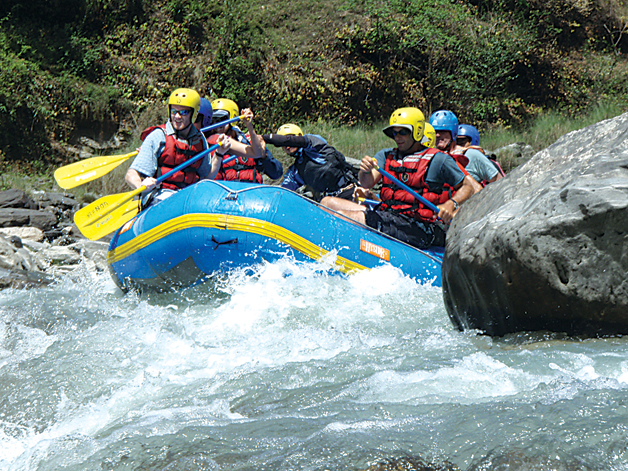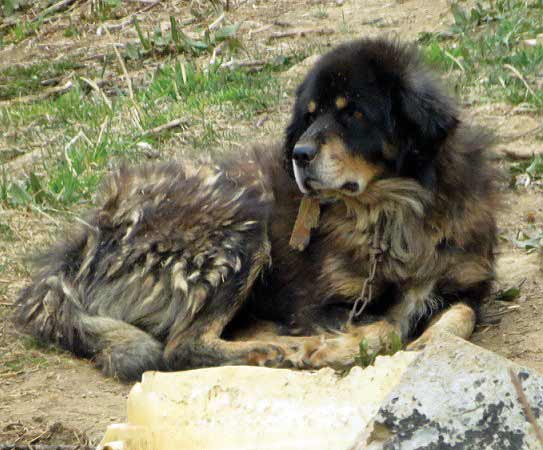
The Himalayan Mountains and its high plateau are responsible for at least 40% of the world’s water.
Therefore is it any wonder that some of the world’s best and wildest rivers are right here coursing throughout the length of Nepal? With rides ranging from the passive Grade I all the way up to the raging Grade VI, there is something to tempt everyone if you wish to see Nepal from a view less seen. And, in a country with so much rafting to offer there is also no shortage of trained professional guides operating on the half dozen established river routes and some recently added newer ones.
Nepal provides an opportunity to travel in a mode that is a little more interesting. With four major river systems flowing through its lands, fed by a staggering, 250 tributaries of reasonable size, altogether they create a transportation network in this watery wonderland, not just for locals, but also for the thrill seekers who come to play every year in what must be one of the world’s wildest and most rugged playground.
The four main river systems are
The Sapta Kosi in the far east.
The Narayani in central Nepal.
The Karnali in the west.
The Mahakali in the far west.
The established river rafting routes are
The Arun is one of the tributaries of the Sapta Kosi River. It generally requires one to fly from Kathmandu to the small airstrip at Tumlingtar. The river itself offers days with easy paddling to days tackling midsize Grade III–IV rapids. Eventually you reach the Sapta Kosi, and eventually joining the mighty Ganges River. The usual packages offered last for about six days from start to finish.
The Bheri offers the paddler four days of rapids ranging from Grade III–VI. Starting out with a flight to Nepalgunj in the west of Nepal and about a three hour drive to Samjhi Ghat, the starting point for the ride. On day two you start straight into some real rapids. Day three and four see more rapids again. Eventually you will arrive at the confluence of the Bheri and Karnali Rivers. Floating on a little further you arrive at Bardia National Park.
The Sun Kosi or ‘River of Gold’ has been rated as one of the top ten rafting rivers in the world, with rapids ranging as high as Grade VI. The trip usually lasts for about ten days. With no shortage of fresh water being fed in along the way as it is joined by the Tamba Kosi, the Dudh Kosi and finally the Big Arun and Tamur Rivers, forming the Sapta Kosi, which eventually joins the mighty Ganges.
This is indeed one of the best river rafting rides and rushes in the entire country. It’s one you are sure to enjoy, taking you through some of the remotest parts of Nepal, down rapids with such daunting names as the ‘Meat Grinder’, ‘High Anxiety’, ‘Jaws’ and ‘Big Dipper’. What more could you ask for out of an adventure holiday?
The Bhote Kosi is considered one of the best rides in Nepal and generally is a two day package that takes you through white water for most of your time, offering Grades between III and VI. The first day you drive about 100km from Kathmandu leaving early and in the water early. Here you can get views of the Ganesh Himal and the mighty Langtang Range. In the water you will raft, plummet and twist through Grades III and IV, at times in a non-stop fashion, eventually pulling out your rafts near the village of Barabise and loading them onto a bus and driving back to the same campsite.
The next day you take it all on again but with an earlier start. You get to see how well you and your team have improved. Instead of stopping at Barabise you continue on and after some flat water all goes crazy as you head towards a dam. The water gets steeper again and now you are really rocking, taking on rapids with names like ‘Liquid Bliss’, ‘My God What To Do’ and culminating in a series named ‘Dazed and Confused’. After this you pull out by mid-day, load up the bus and hightail it back to Kathmandu.
The Trisuli is by far one of the most easily accessible rivers in Nepal. Though usually only a two-day journey, it’s possible to mould your own itinerary a little. The journey takes you through steep gorges with some wonderful Grade II and III rapids as you work your way through the land of Magars and Gurungs in the hills of the Mahabarat Range, eventually arriving on the plains of the Terai. After it is joined by the larger Kali Gandaki it becomes the Narayani, which flows past the rich farmlands of the Chitwan Valley and ultimately through Chitwan National Park towards its rendezvous with India and the Ganges. Floating to Chitwan is a much better ride than on the bus!
The Seti is one of the softer and gentler trips to take by raft in Nepal. Winding your way through the middle hills of the country. The trip usually takes about two days to complete. With the maximum rapids being of a Grade III caliber. The rafts make their way through the remnants of the vast forests that once covered Nepal’s Mahabharat Lekh (the mid-hills), offering you a chance to see local wildlife in a most calm fashion, in amongst the lush vegetation.
You will travel along the Seti Khola past Magar villages, often with many of the inhabitants stopping to watch the spectacle. After a while the Seti joins the Trisuli River and as the hills fade away you find yourself floating through the plains of the Inner Tarai. Then you come to Devighat, a site of religious importance to Hindus where thousands of pilgrims come each year. Here the Trisuli is joined by the Kali Gandaki River, and the waters are, hereafter, known as the Narayani.
The Marsyangdi is one of Nepal’s most technically tough rivers, which requires true skill and commitment from the entire crew. Even more so than on other big rivers like the Sun Kosi and the Karnali. The Marsyangdi begins on the eastern side of the Annapurnas and requires both a bus journey and a trek to get to the starting point. The river itself gives the paddlers the opportunity to see the surrounding mountains a new way each time.
The standard package for this river is about five days, including the bus ride and trek. Then, it will be thrill ride after thrill ride, taking on the rivers Grade IV rapids.
The Kali Gandaki adventure begins with your pick-up in Pokhara, from where after you will drive for about three hours to the starting point. The Kali Gandaki itself is one of Nepal’s holiest rivers. All along its banks you will see numerous religious sites, particularly cremation areas and shrines. The Kali (kali means ‘black’) begins high up on the Tibetan Plateau in the Mustang Region and hurtles down the Himalayas and carves the worlds largest gorge slap bang between Daulagiri and Annapurna, both 8000m+ peaks.
The usual package lasts for three days and takes in white water that ranges from Grade III to VI. Day one alone sees you taking on two big Grade IV rapids. Most of the rapids are pool drops and have surfing waves. As you descend you will travel between steep cliffs and lush countryside with a host of local people out to watch your mad-capped progress.
The Karnali Nepal’s longest and largest river begins at the base of Mount Kailash in Tibet. Buddhists consider it the centre of the universe, while for Hindus it is the home to the mighty Lord Shiva. The Karnali is one of the finest BIG volume river trips in the world, but it also provides a wonderful journey through Nepal’s remote western hills. From the starting point at Sauli the river drops into canyons filled with powerful, big volume white water. These canyons flow though scarcely populated areas of pristine jungle teeming with abundant bird and wildlife.
The rapids on this 11day journey vary from Grade III to IV+ and are separated by just enough easy water to prepare yourself for the next round. Towards the end of the trip the river gradient begins to ease as the Karnali leaves the mountains and flows out onto the Gangetic plains of Nepal’s Terai lowlands. The jungle thickens as the river broadens, and the beautiful beaches become more alluring. Finally you arrive in Bardia National Park. This journey requires a long bus trip both at the start and end, so be prepared.
Information sourced and available from: www.raftingassociation.org.np, the website for the Nepal Rafting Association Agents (NARA)

Massage Away your Stress
A Five Thousand-Year-old Ayurvedic massage helps you de-stress from your hectic life. Life brings in a lot...








